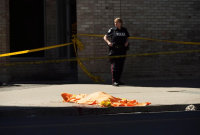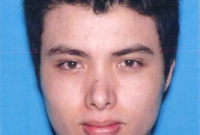Support strong Canadian climate journalism for 2025
Konstantin Goulich had only travelled steps from his apartment building before he saw the first dead body.
The second one lay a block or two to the south. Nearby lay a third, draped like the others in an orange blanket that only drew attention to the horror that had just transformed countless lives.
The bustling but peaceful streets Goulich had planned to stroll on a balmy, sunny April day had become a grisly crime scene in the wake of a deadly rampage allegedly carried out by a 25-year-old man behind the wheel of a rented van.
While Goulich was not among the 10 people killed or the 16 others injured that day, he said he's struggled to come to grips with the "terrible" sights he saw.
"I'm definitely not getting much sleep, that's for sure," Goulich said. "On the first night I couldn't sleep at all. I just had the image of the person under the blanket."
Stories like Goulich's will be common as the events of April 23 truly sink in, experts said, adding the witnesses to the violence that took place on Yonge Street should be considered victims of the attack in their own right.
Dr. Katy Kamkar, clinical psychologist at the Centre for Addiction and Mental Health, said the carnage that resulted from Alek Minassian's alleged rampage would be genuinely traumatic for everyday residents to take in.
The sights and sounds that filled the streets that day not only lodge in people's minds but also tear at their belief systems, she said, adding such events can leave people questioning fundamental pillars of their life such as the safety of their society and the foundations of their faith.
In the immediate aftermath of such developments, Kamkar said it's entirely normal for witnesses to struggle with the new information they've been forced to take in.
Symptoms such as sleeplessness, anxiety, recurring mood swings, fear and grief are all normal at this early stage, Kamkar said, adding there is no single appropriate way to process such "horrific images."
"It's important to expect all those and also not to be afraid of the symptoms, she said.
Coping mechanisms may vary, Kamkar said, adding what works for one person may have an entirely different effect for another.
Many mourners have congregated at the site of the attack in the days since it happened, and revisiting the scene proved unhelpful for one witness.
Mandana Kanani was sitting outside her dry cleaning shop across the street when she saw the van speed along the sidewalk and run over a fire hydrant before continuing southbound, leaving four bodies in its wake.
Since then, she said it's been hard to shake the images and the sense of guilt she felt for being unable to help.
"I was obliged to go to that side (of the street) and I felt really bad walking over there," she said.
But one person's struggle can be another's salvation.
Dainis Cevers admitted to being in a state of shock after finding himself behind the van Minassian was allegedly driving and witnessing one pedestrian being hurled at least five metres through the air.
Days later, Cevers returned to the scene after paying tribute at a makeshift memorial that sprang up since the attack.
While there, he said he connected with the family of one of the victims. The exchange they had, he said, allowed him to commiserated and share his perspective on what happened.
"It was good to meet them," he said. "I was explaining that this could happen to anyone. There's nothing to be done. It could happen to me, to anyone."
Such closure has not yet come to Mario Martella, who saw the body of an elderly woman lying just outside the neighbourhood hair salon he owns.
"It's terrible, terrible. It will remain in my mind for I don't know how long," he said. "But you can't think about it."
Dr. Sylvain Roy, president of the Ontario Psychological Association, said that approach may not be best for everyone.
He said that while the symptoms many people exhibit in the days after a traumatic event dissipate in most cases, some people see them intensify until they interfere with daily functioning.
"Whoever witnesses directly will probably be impacted for life in one way, shape or another," he said. "Some of these individuals will need to talk to somebody. The idea of connecting with family and friends, but also accessing professional help if needed, I think that's going to be something we need to focus on."
Kamkar agreed, saying people with escalating symptoms may find themselves on the road to depression, post-traumatic stress disorder or other psychological conditions without the right interventions.
Both urged people needing help to reach out to the community supports in their area.
In the meantime, Kamkar said witnesses struggling to come to terms with Monday's traumatic events may want to concentrate on slowly re-establishing a normal routine.
"Focus on setting goals, setting activities," she said, adding they could be as simple as going for a 10-minute walk or making one phone call to a friend or loved one "Any kind of routine that helps us to go one step forward."
— With files from Peter Goffin and Liam Casey





Comments